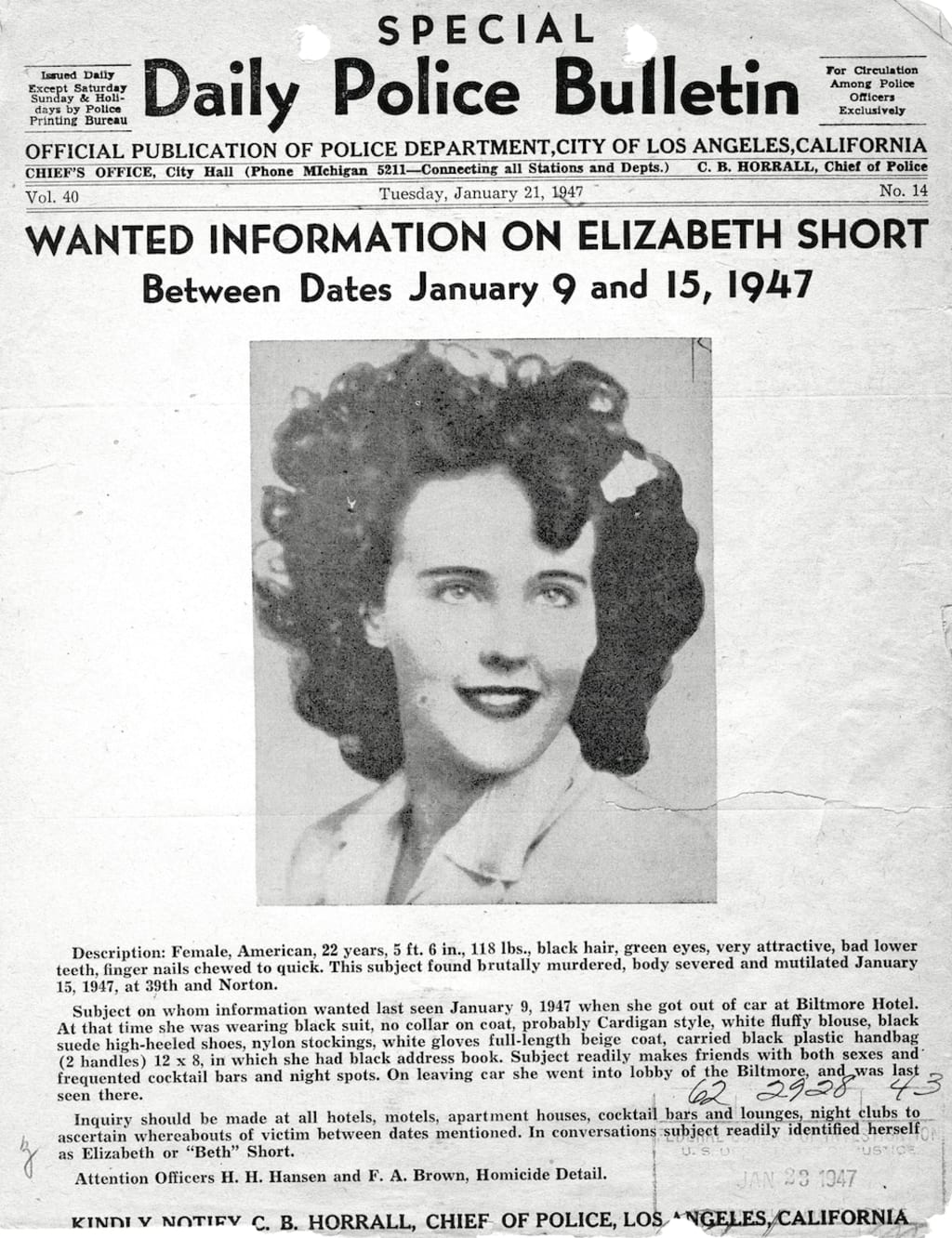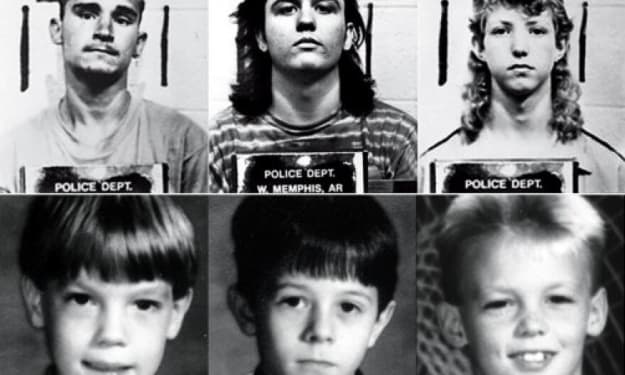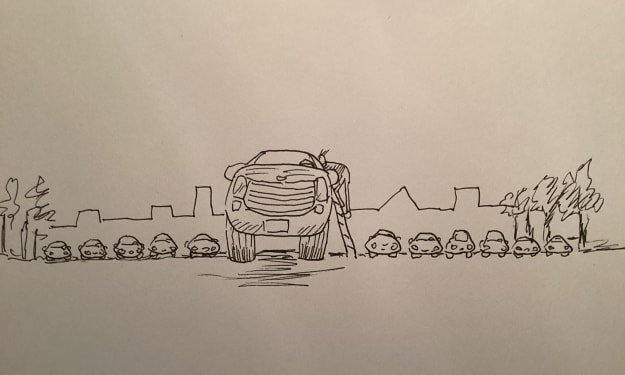Top 10 interesting facts in "The unsolved case of the Black Dahlia”
The Black Dahlia murder, the unsolved killing of Elizabeth Short in 1947, remains one of the most famous unsolved cases in American history.

The unsolved case of the "Black Dahlia" murder is one of the most famous unsolved crimes in American history. On January 15, 1947, the body of Elizabeth Short, a young woman with aspirations of becoming an actress, was found brutally murdered and mutilated in Leimert Park, Los Angeles. The nickname "Black Dahlia" was given to her by the press due to her rumored penchant for dark clothing and her rumored involvement in a scandalous affair. The case drew widespread media attention and became one of the most high-profile unsolved murders in American history. Despite numerous investigations, leads, and theories, the case remains unsolved to this day.
- The victim, Elizabeth Short, was given the nickname "Black Dahlia" by the press due to her rumored penchant for dark clothing and her rumored involvement in a scandalous affair. Elizabeth Short was born in Boston, Massachusetts in 1924. She was an aspiring actress and moved to Los Angeles in the 1940s to pursue her dreams. Despite her ambition, she had a difficult time finding success in Hollywood and often struggled financially. She worked as a waitress, a sales clerk, and a model to make ends meet. She also had a reputation for being promiscuous and had several relationships with men, which led to the rumor of her involvement in a scandalous affair. Her relationships were often tumultuous and she was known to have a wild and carefree lifestyle which led to her being labeled as a "party girl" by the press.
- Elizabeth Short's body was found in Leimert Park, Los Angeles, on January 15, 1947. Her body was cut in half at the waist, and both halves were placed several feet apart. She was also severely mutilated, and her face was slashed from the corners of her mouth to her ears in what was referred to as a Glasgow Smile. This gruesome discovery quickly caught the attention of the media and the public. The LAPD immediately launched an investigation and the case was quickly dubbed as the "Black Dahlia" murder, a nickname that has stuck with the case ever since. The condition of the body, the nature of the injuries, and the location of the body all suggested that the murder was committed by someone with a deep knowledge of anatomy and surgical skills.
- The case drew widespread media attention and became one of the most high-profile unsolved murders in American history. The LAPD received over 60 confessions in connection to the case, but none of them were found to be credible. The investigation was hampered by a lack of physical evidence, and the LAPD was criticized for their handling of the case. The LAPD's inability to solve the case led to public frustration and mistrust of the police department. The press coverage of the case was intense and sensationalized and this led to many people coming forward with false confessions and leads that hindered the investigation.
- Many people came forward claiming to have information about the case, but most of the leads were false and the case went unsolved for decades. The LAPD received thousands of tips and letters, but none of them led to a solid suspect. Some of the letters were even believed to be hoaxes, sent by people looking for attention or to mislead the investigation. The number of false leads and inaccurate information made it difficult for the LAPD to focus on the credible leads and hindered their investigation. The LAPD had to sort through a high volume of leads and information, which was time-consuming and resource-intensive. Some of the leads were investigated multiple times, but each time they led to a dead end. The case became one of the largest and longest investigations in the history of the LAPD, with over 150 detectives working on the case at its peak. Despite the large number of leads and suspects, the case remains unsolved to this day.
- Several suspects were named in the case, including Dr. George Hodel, a physician who was investigated for the murder but never charged. Dr. Hodel was considered a suspect due to his proximity to the crime scene and his mysterious behavior during the investigation. He was known to have had a relationship with Elizabeth Short, and was observed by investigators to have acted suspiciously during the investigation. He was even wiretapped by the LAPD, but no concrete evidence linking him to the crime was found. Despite this, some people still believe that he was the Black Dahlia killer. In recent years, his own son, Steve Hodel, has publicly accused him of being the killer, citing evidence found in the form of photographs and diary entries. However, this evidence has not been conclusively proven and the LAPD never formally charged Dr. Hodel with the crime.
- In the years following the murder, several books, articles, and movies have been made about the case, further fueling public interest and speculation. The Black Dahlia case has been the subject of numerous books, articles, TV shows, and movies over the years. Some of the works were based on factual information and others were fictionalized accounts of the crime. This has kept the case in the public consciousness and has led to many theories and speculations about who the killer might be. The media attention and public interest in the case has also led to an influx of false confessions, hoaxes and misinformation making it difficult for the authorities to identify the real perpetrator.
- Short's murder was never solved, but over the years, several people have claimed responsibility for the crime, but their stories were never verified. Many people have come forward over the years, claiming to have killed Elizabeth Short, but none of these claims have been proven to be true. Some of these claimants were proven to be lying, and others were not connected to the crime in any way. Some of these confessions may have been made by attention-seekers, while others could have been made by mentally ill individuals. Some of these confessions were written letters, while others were verbal statements made to the authorities. The LAPD investigated each of these confessions, but none of them led to an arrest or conviction. Some experts suggest that the high volume of false confessions and inaccurate information made it difficult for the authorities to identify the real perpetrator.
- Many theories have been developed over the years, including that the murder was committed by a Hollywood figure, a criminal, or a member of the military. Some people have suggested that Elizabeth Short's murder was committed by someone connected to Hollywood, due to her aspirations to be an actress. Others have suggested that the killer was a criminal or a member of the military. Some of these theories were based on circumstantial evidence, such as the victim's background and the nature of the crime. But many of these theories were not supported by concrete evidence, and were ultimately disproved by the investigation.
- In recent years, new forensic techniques have been applied to evidence from the case, but the case remains unsolved. With the advancement of forensic technology, new evidence has been examined and re-examined in the hopes of finding new leads in the case. However, despite these efforts, the case remains unsolved and the killer's identity remains a mystery. Some experts believe that the lack of DNA evidence and the fact that the crime happened decades ago, make it unlikely that the case will ever be solved.
- In recent years, new forensic techniques have been applied to evidence from the case, but the case remains unsolved. With the advancement of forensic technology, new evidence has been examined and re-examined in the hopes of finding new leads in the case. The LAPD has re-opened the case several times over the years, and have used new technologies such as DNA testing and fingerprint analysis to try and find new leads. Despite these efforts, the case remains unsolved and the killer's identity remains a mystery. Some experts believe that the lack of DNA evidence and the fact that the crime happened decades ago, make it unlikely that the case will ever be solved. Furthermore, the condition of the evidence at the time of the crime which was not properly stored and mishandled may have affected the quality of the evidence making it impossible to extract new information using current forensic techniques.
The Black Dahlia case has been a source of fascination for many people for decades, both for its gruesome nature and for its unsolved status. Despite the numerous investigations, leads, and theories that have been put forth over the years, the case remains unsolved. The LAPD received over 60 confessions in connection to the case, but none of them were found to be credible. The investigation was hampered by a lack of physical evidence, and the LAPD was criticized for their handling of the case. The case continues to inspire interest and speculation to this day. The case remains one of the most famous unsolved murders in American history, and it will continue to be a mystery that many will try to solve.
About the Creator
Enjoyed the story? Support the Creator.
Subscribe for free to receive all their stories in your feed. You could also pledge your support or give them a one-off tip, letting them know you appreciate their work.





Comments
There are no comments for this story
Be the first to respond and start the conversation.